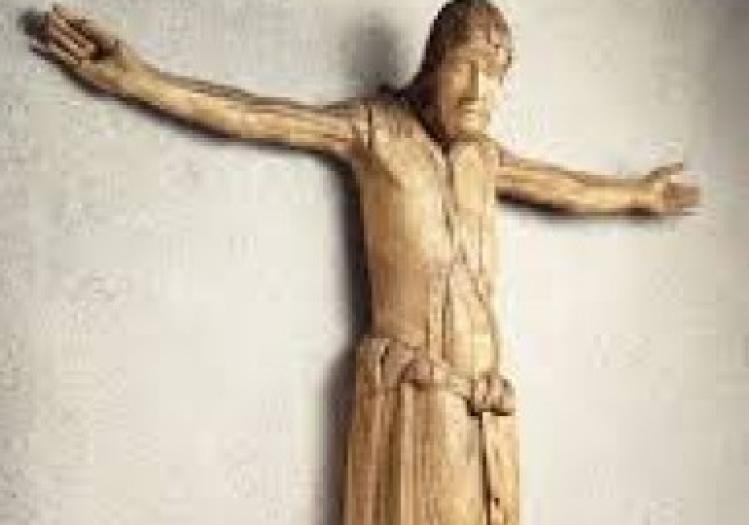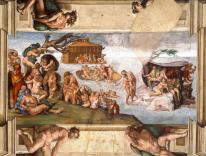
To the good fortune of visitors to the Metropolitan Museum of Art, the Hildesheim Cathedral in Germany is undergoing major renovation and has sent some of its most beautiful medieval objects to New York. The cathedral’s great bronze doors and famed column cannot travel, of course, but two monumental pieces have made the trip—the lifesize Ringelheim Crucifix (c. 1000) and a bronze baptismal fount (c. 1226) with extraordinarily detailed iconography—and they abundantly repay a visit.
Entering from the Medieval Sculpture Court, you come first upon the font, six feet high and resting on four kneeling figures representing the Rivers of Paradise. A relief scene of the baptism of Jesus, standing in a beautifully stylized Jordan River, evokes the power of the sacrament. Opposite it, a Virgin Enthroned is accompanied by the patron saints of the cathedral.
At the center of the gallery beyond is the crucifix, actually the corpus from a cross lost long ago. Once you have seen it, you will never forget it. Originally polychromed, the now-bare linden wood suits modern taste (the arms, added a century later, are of oak), and even though this is a cross of triumph—Christ’s eyes are open, and he seems more to stand before the cross than to hang on it—the rueful, questioning expression on his face speaks strongly to modern anxiety. To say that the figure compares to the slightly earlier Gero Crucifix in Cologne Cathedral is to suggest its artistic and religious power.
The crucifix was probably commissioned for the abbess of the convent in Ringelheim by her brother, Bernward, bishop of Hildesheim from 993 to 1022 and one of the greatest art patrons of the Middle Ages. In addition to commissioning the doors and triumphal column for St. Mary’s Cathedral, Bernward planned and furnished the Abbey Church of St. Michael’s, whose cornerstone was laid in 1010. Of the treasures in the Met’s show he is the likely patron of the so-called Golden Madonna, a Virgin and Child Enthroned, from the early Middle Ages (both heads have unfortunately been lost); the delicate but powerful Bernward Cross in silver with gilding (Bernward himself may have made it); a pair of richly decorated silver candlesticks; and the “Precious Gospels,” full of exquisite illuminations of scenes from the life of Christ and bound with handsome covers.
Bernward’s successor, Godehard, was even more revered for his modest saintliness. Under Godehard the famous cathedral school continued to flourish, and so did artistic creativity in Hildesheim, as documented in the show by illuminated manuscripts, richly decorated crosses, portable altars, and highly imaginative reliquaries—one for the arm of a military saint, one for the skull of St. Oswald, and another created for the arm of Bernward after his canonization in 1192.
The city during this time—one of the larger in Northern Germany, with a population over five thousand—became increasingly famous for its bronzes, as you see at the Met in a commanding lectern in the form of an eagle and in an aquamanile, a vessel for washing hands, in the popular shape of a lion. But tensions were mounting between the laity and the bishops, and by 1249, when a city charter was adopted, the course was set for a shift of power from clergy to laity. The late Middle Ages would see few significant works of art entering Hildesheim’s churches.
Reviewing this show about works of art so apparently distant from us, New York Times critic Holland Cotter commented that “you just have to be willing to stop, pay attention, spend time, to act as if objects from the past had something true to tell you about your life in the present, how to live it, what to feel about it.” If you do this, you may even find that these remarkable objects are praying for you this Advent.
Please email comments to [email protected] and join the conversation on our Facebook page.
Share
Previous Story
Letters | Chatting with Francis, the church & the Jews
Next Story
Poem | Raising the Eyes That High


